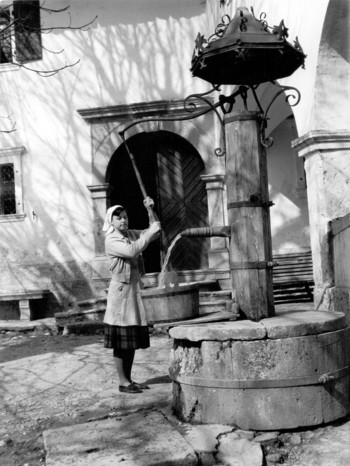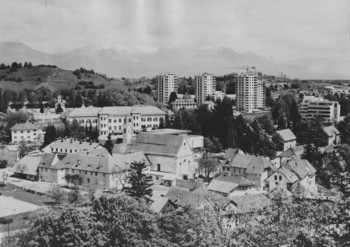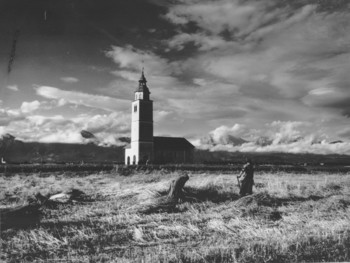Tone Mlakar, Photographer
Nina Misson
Tone Mlakar (1921–2020) was a versatile creator and an amateur photographer, who pursued photography with great seriousness and true zeal. As a photographer, he was best known for his picturesque photos of the town of Škofja Loka and the surrounding area. His oeuvre created over many years is thus deservedly one of the most detailed photographic chronicles of the town and its people. His photographs depict, among other things, some parts of human creation and activity that are now long gone. The research into Mlakar's extensive archive, which took place during the preparatory and research stage of the project Photo Loka: Creating Škofja Loka's Photographic History, included a number of meetings with Tone Mlakar himself and his son, Simon. These meetings, which were held in Mlakar's home from November 2019 until late January 2020, were focused on going through numerous boxes with photos to learn when and where the photos had been taken. During the meetings, Tone and Simon both shared interesting details about the Tone’s photographic process and his fascinating life.
Mlakar, who worked as an architect for most of his professional career, took his camera to many different places both during his working hours and his free time, visually recording the places he visited. He photographed in all sorts of conditions and situations, and had many anecdotes to share. For instance, some of his photographs were taken from a bird's-eye view during flights with a friend of his who was a pilot, some other were taken from utility poles. In addition to his tireless work, he was also very active in the organisational field, i.e. he was one of the founding members and the first vice-chairman of the Anton Ažbe Photo Club Škofja Loka (established in November 1985). After decades of continuous and tireless work, the Photographic Federation of Slovenia awarded him the Puhar Lifetime Achievement Award in 2013.
As previously mentioned, he was first and foremost an architect and, during his career spanning over 30 years, he designed many buildings and was in charge of numerous renovation projects in Škofja Loka and the surrounding area. Thus, he contributed significantly to the local cultural landscape and the way it was shaped. As an employee of the SGP Tehnik architectural firm, he designed many projects that are now an important part of the town and a wider area, including the Škofja Loka bus station, the original bridge from the Cankar square to the bus station, the Novi svet residential area, the renovation of the Ajman Castle in Sveti Duh and the renovation of the local cinema (Kino Sora). He often captured his architectural and engineering projects on photos, which eventually gained immense documentary and historical value.
He was an excellent drawer and a successful film set designer from a young age, even while he was still studying. He was one of the last students (he graduated in 1954) to study under the mentorship of the famed Slovenian architect Jože Plečnik. Owing to his subtle innate sense of the landscape, Mlakar won Plečnik's praise and recommendation, which eventually led to him being involved in the establishment of Slovenian cinematography. In 1947, the company Triglav film had a call for participation, offering young filmmakers an opportunity to study in Prague. Plečnik repeatedly emphasised in front of everyone that Mlakar “had a good sense of scenic design. It’s him we are sending to Prague.” Professor Edvard Ravnikar also heard that Mlakar was a good drawer and, relating to the call for participation, asked him if he would like be involved with filmmaking.
According to Mlakar himself, this “paved his way to filmmaking”. In the spring of 1947, he left for Prague to study film set design. While there, he got special treatment as Plečnik's student: “Simply mentioning Plečnik's name in Hradčany, where the Republic's presidency was located ... when I went to see the vaults, all the doors were immediately opened for me.” He returned to Ljubljana just before the filming of the first Slovenian feature film Na svoji zemlji (On Our Own Land; 1948), where he was responsible for the set design at the Baška grapa filming location. Later, he also worked as a set designer for Triglav Film production company's other films, such as Kekec (1951), Balada o trobenti in oblaku (The Ballad of the Trumpet and the Cloud; 1961) and Srečno Kekec (Good Luck, Kekec; 1963). All this work was project-based and his income was thus irregular, so eventually he returned to architecture for good.
During his film production work, he often went location scouting and while doing so, he got to know many picturesque sights in his surroundings, which was part of the reason for his focus on photography. He kept his camera always at hand, and “whenever he saw something beautiful”, he took some photos. Thus, he gradually built up an extensive collection of photographs, which he organised with great care and meticulousness over the years. In his personal archive, each Slovenian region had its own section, and the photographs were divided into boxes by even smaller regional areas, as well as subjects. For example, the boxes were labelled as the Selca Valley, Škofja Loka – surrounding area, Škofja Loka – town, Škofja Loka – winter, etc.
Mlakar's earliest encounter with photography was when he was a secondary school student in Ptuj. The boarding school students had a photographic laboratory at their disposal and they took photos with simple Kodak cameras. During his studies, he used a Kodak Retina camera to photograph the works of Professor Plečnik. However, he did not get more serious about photography until later, when he was so awed by the snow-covered scenery while skiing on Komna that he wanted to capture it in a photograph as he believed his drawings could not capture it well enough. From then on, photography was his hobby and obsession. Although he was an immensely prolific photographer, he never had a dedicated darkroom. His son Simon remembers that, for the most part, his father developed photos in the bathroom of their home. Due to working in less than perfect conditions, his prints were of variable quality. “You have no idea how many times the paper was under the enlarger, how many sheets went through it,” said Mlakar during a conversation about developing photos. His photographic archive, which was a long time in the making, from the 1950s until 2010, is consequently extremely extensive, estimated at 3,000 prints as well as around 14,000 shots on the negatives.
When asked about his favourite subject to photograph, he did not hesitate to answer: “architecture and landscape”. What he had in mind when mentioning architecture is primarily the architecture of our ancestors, as he had great respect and admiration for the tradition of the people who had lived here before us, and “our folklore”. In an interview with Jože Možina for the RTV Slovenia series Pričevalci, he said, “Our ancestors were incredibly smart people and they are a pleasure to imitate.”
As an architect, Mlakar preferred preserving and restoring existing buildings to demolishing old ones and then building new ones in their place, and in a similar vein, as a photographer he documented and preserved both cultural and natural heritage. As an architect and urban planner, he regretted some of his decisions, which, he believed, had ruined the former rural idyll. He was more proud of his work on sacred buildings than his city projects, and in his old age he paid a lot of attention to churches and church cemeteries. He regretted that because of his job he was forced to “chase farmers off their land” in order to gain space for new residential neighbourhoods. He wished he had been able to capture the bygone farmer's life in an even more picturesque way and to take more photos of farm life while he still had the chance. Asked if he had ever felt uncomfortable photographing farmers while they did farm work, he replied, “They weren't bothered about me taking photos of them in the slightest. I was not lucky enough to have a bit more farmer's life here ... there's too little farmer's life in here [in his photographic archive], it's a pity, such a pity, for history as such.”
As change is the only constant in life and in the world, looking at Tone Mlakar's work from a distance makes it even more valuable, as he managed to capture something that may very well seem everlasting at some point, but can end up disappearing soon. Mlakar's photographs thus show many bygone and long-forgotten spaces, metaphorically illustrating the time that has already passed. To say that Mlakar was “drawn to old things” would be an exaggeration, he did, however, always look for what he had to leave behind at a young age, what he missed for so long. He consequently wanted to capture and preserve his memories and nostalgia for all eternity. As a photographer, Mlakar can therefore be viewed, first and foremost, as a chronicler of a bygone age, of idyllic scenes and relics of the past. In an interview for the Dnevnik newspaper in 2013, he said the following: “Photography is the true imprint of the times. Buildings may be torn down, the landscape changes, so do villages and towns. But photos remain.”




